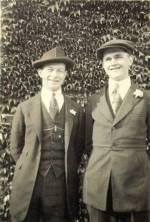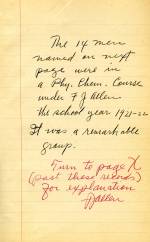|
Hooks and eyes: That was the description of bonds between atoms that Pauling learned
when he was an undergraduate at the Oregon Agricultural College. Each atom had a certain
number of hooks that allowed it to attach to other atoms, and a certain number of
eyes that allowed other atoms to attach to it. A chemical bond (a bond between atoms
that held them together as molecules) resulted when a hook and eye connected.
This described a bond, but it explained very little. At least it took into account
the century-old ideas of the great English chemist John Dalton, who in the early nineteenth
century theorized that atoms — which came in distinct sizes, called elements — combined
with other atoms in simple whole-number proportions to form larger molecules. As is
known today, two hydrogen atoms and one oxygen atom join to form water, four hydrogens
and one carbon form methane, and so forth. The element’s combining capacity or "valence"
— its number of hooks and eyes — was set somehow by nature. But no one knew why elements
combined in just these proportions, or what forces held them together.
Linus Pauling intended to solve these mysteries by applying the new physics he had
learned in Europe.
|
|
Click images to enlarge

Linus Pauling and his friend Paul Emmett. 1920.

Notes on fourteen 1921-1922 Oregon Agricultural College physical chemistry students,
including Linus Pauling. 1961.
"I can remember that I was asked, perhaps when I was a junior, if I would give some
lectures in the evening for students who were having trouble in freshman chemistry
. . . I can remember presenting chemical bond theory on the 'hook-and-eye' basis .
. . [When] I ran across the papers by Langmuir which were published that year . .
. I was very impressed by this work on the electronic structure of molecules or ideas
about shared electron pair bonds, and it may well be that that was the start of my
interest in chemical bonding."
|

